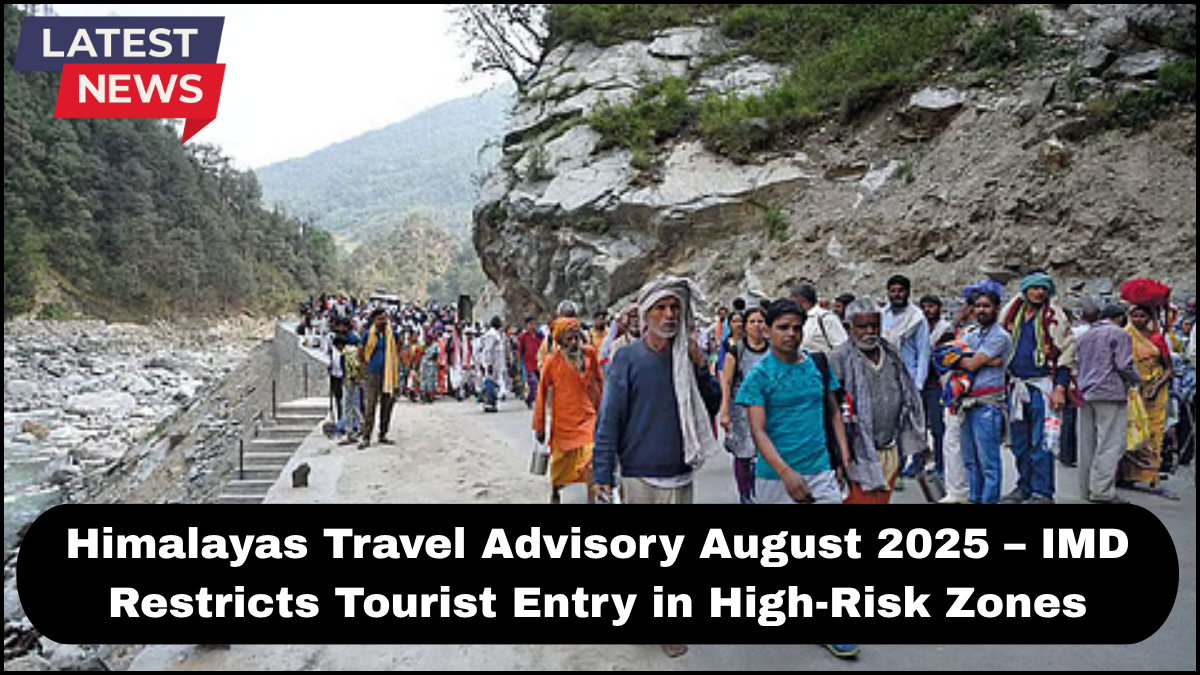As monsoon intensifies across northern India, the India Meteorological Department (IMD) has issued a fresh weather advisory for tourists, enforcing Himalayas travel restrictions in August 2025. This latest directive comes in response to escalating natural hazards, including landslides, flash floods, and road blockages that have disrupted life in several mountainous regions.

Why the Restrictions Are Being Imposed
Every year, the Indian Himalayas attract thousands of trekkers, pilgrims, and nature lovers. However, the unpredictable weather patterns brought by the monsoon have significantly increased the risks for travelers.
In August 2025, states like Himachal Pradesh, Uttarakhand, and parts of Jammu & Kashmir have reported intense rainfall, leading to multiple instances of:
- Cloudbursts and sudden deluges
- Overflowing rivers and damaged bridges
- Large-scale landslides blocking highways
- Helicopter evacuations from remote valleys
IMD officials have noted that these regions are currently facing “severe to extremely severe” weather conditions. In light of these threats, entry to certain high-altitude locations has been restricted for tourists and non-residents until further notice.
Areas Affected by the Travel Ban
While the travel restrictions don’t cover the entire Himalayan belt, they are particularly strict in zones identified as high-risk. As per the advisory, these include:
- Kinnaur and Lahaul-Spiti (Himachal Pradesh)
- Chamoli, Rudraprayag, and Uttarkashi (Uttarakhand)
- Poonch and Kupwara (Jammu & Kashmir)
Local administrations in these areas have already begun setting up checkpoints to stop unauthorized travel. Helicopter services and trekking permits have been suspended, and tourists currently in these zones are being advised to evacuate with assistance from state disaster response teams.
The Role of the IMD’s Weather Monitoring System
The IMD has deployed its real-time satellite monitoring and Doppler radar systems to predict rainfall patterns more accurately. Using this data, they issue hourly weather alerts that are being shared with district authorities and travel operators.
This advanced system has been critical in providing early warnings, helping prevent loss of life and property. However, due to terrain challenges and communication issues in remote zones, tourists are advised to stay connected with local news sources and weather apps that relay IMD alerts.
What Tourists Should Know Before Planning a Trip
If you’re planning a Himalayan escape in August 2025, it is crucial to check travel advisories before departure. Here are a few precautions to follow:
- Avoid unapproved travel to restricted zones, even if local guides offer passage
- Postpone treks and camping trips until conditions stabilize
- Carry emergency supplies and satellite communication tools if already in high-altitude areas
- Purchase travel insurance that covers natural disasters and evacuation
In addition, travelers should be aware that mobile networks and internet connectivity in many remote areas are unreliable during monsoon.
Tourism Impact and Government Measures
While these Himalayas travel restrictions in August are temporary, they have had a significant impact on local tourism-dependent economies. Hotel bookings have plummeted, and several tour operators have paused operations.
To mitigate this, state governments are coordinating with the IMD, Border Roads Organisation (BRO), and the National Disaster Management Authority (NDMA) to restore access roads and ensure safe zones remain open. Alternate itineraries and buffer zones have also been suggested for tourists seeking a safer travel experience.
Frequently Asked Questions (FAQs)
Q1: Are the Himalayas completely closed for tourists in August 2025?
No, only specific high-risk regions have been closed as per IMD directives. Many popular destinations in lower altitudes remain open but require caution.
Q2: How long will the travel restrictions last?
There is no fixed end date. The restrictions will continue until the IMD declares the weather conditions safe.
Q3: Can I still trek in the Himalayas this August?
Trekking in restricted zones is banned. Alternative trekking routes in safer areas may still be open, but only with official permits and proper guidance.
Q4: Where can I get real-time weather updates?
You can check the IMD’s official website or use trusted weather apps that source IMD data. Local news portals also share regular updates.
Q5: Is travel insurance mandatory for visiting the Himalayas?
It is not mandatory but highly recommended, especially during monsoon months when natural risks are high.